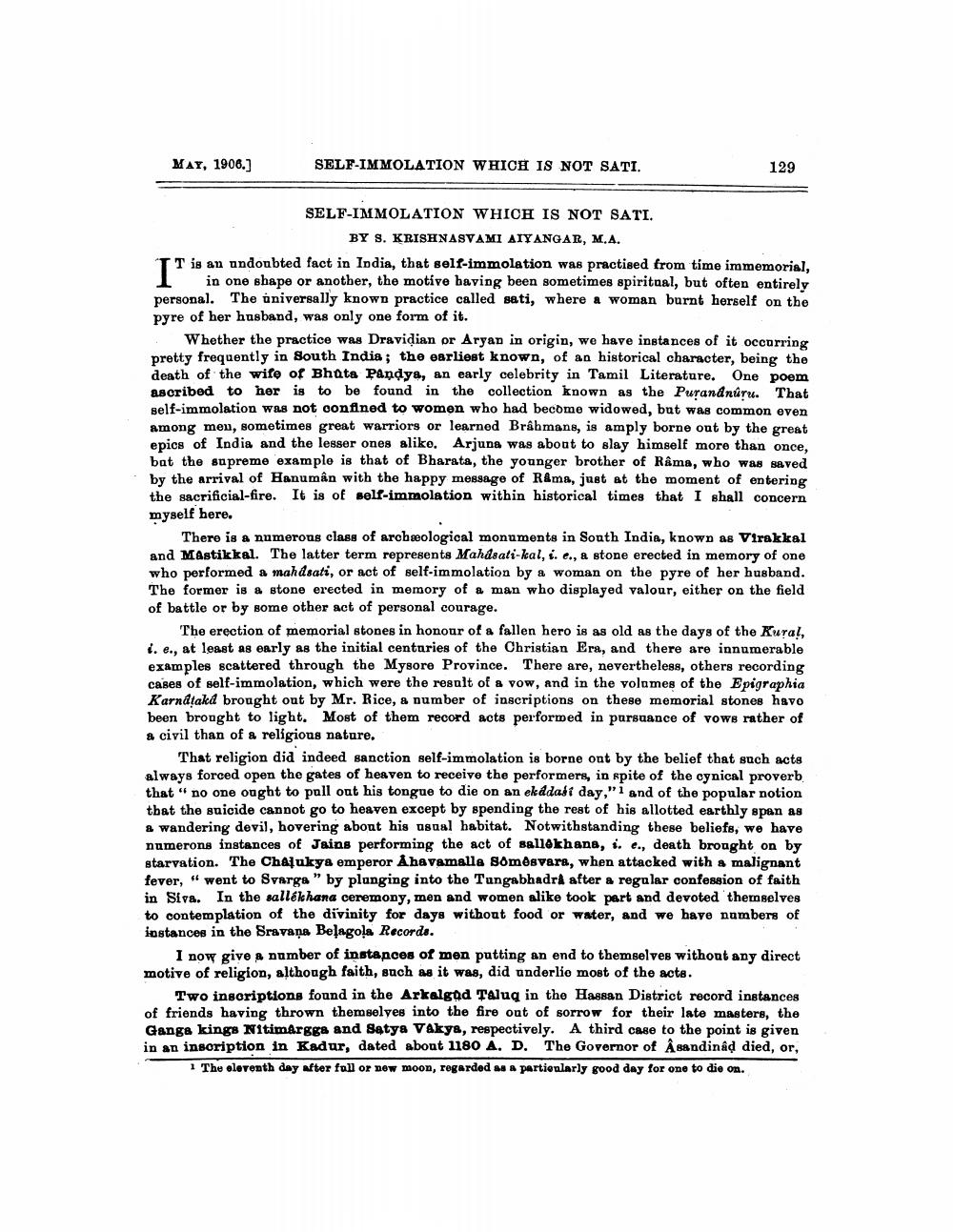________________
MAY, 1906.]
SELF-IMMOLATION WHICH IS NOT SATI.
129
SELF-IMMOLATION WHICH IS NOT SATI.
BY S. KRISHNASVAMI AIY ANGAR, M.A. TT is an undoubted fact in India, that self-immolation was practised from time immemorial, 1 in one shape or another, the motive having been sometimes spiritual, but often entirely personal. The universally known practice called sati, where a woman burnt herself on the pyre of her husband, was only one form of it.
Whether the practice was Dravidian or Aryan in origin, we have instances of it occurring pretty frequently in South India; the earliest known, of an historical character, being the death of the wife of Bhata Pandya, an early celebrity in Tamil Literature. One poem ascribed to her is to be found in the collection known as the Purandnúru. That self-immolation was not confined to women who had become widowed, but was common even among men, sometimes great warriors or learned Brahmane, is amply borne out by the great epics of India and the lesser ones alike. Arjuna was about to slay himself more than once, bat the supreme example is that of Bharata, the younger brother of Râma, who was saved by the arrival of Hanuman with the happy message of R&ma, just at the moment of entering the sacrificial-fire. It is of self-immolation within historical times that I shall concern
myself here.
There is a numerous class of archaeological monuments in South India, known as Virakkal and Mastikkal. The latter term represents Mahdsati-kal, 6. e., a stone erected in memory of one who performed a mahdsati, or act of self-immolation by a woman on the pyre of her husband. The former is a stone erected in memory of a man who displayed valour, either on the field of battle or by some other act of personal courage.
The erection of memorial stones in honour of a fallen hero is as old as the days of the Kural, 1. e., at least as early as the initial centaries of the Christian Era, and there are innumerable examples scattered through the Mysore Province. There are, nevertheless, others recording cases of self-immolation, which were the result of a vow, and in the volumes of the Epigraphia Karndtakd brought out by Mr. Rice, & number of inscriptions on these memorial stones havo been brought to light. Most of them record acts performed in pursuance of vows rather of a civil than of a religious nature.
That religion did indeed sanction self-immolation is borne ont by the belief that such acts always forced open the gates of heaven to receive the performers, in spite of the cynical proverb that no one ought to pull out his tongue to die on an ekddafi day," and of the popular notion that the suicide cannot go to heaven except by spending the rest of his allotted earthly span as a wandering devil, hovering about his aspal habitat. Notwithstanding these beliefs, we have numerons instances of Jains performing the act of sallekhana, s. e., death broaght on by starvation. The Chalukya emperor Ahavamalla somôsvara, when attacked with a malignant fever, " went to Svarga" by planging into the Tangabhadrà after a regalar confession of faith in Siva. In the sallékhana ceremony, men and women alike took part and devoted themselves to contemplation of the divinity for days without food or water, and we have numbers of instances in the Sravana Belagoļa Records.
I now give a number of instances of men putting an end to themselves without any direct motive of religion, although faith, such as it was, did underlio most of the acts.
Two insoriptions found in the Arkalgad Talug in the Hassan District record instances of friends having thrown themselves into the fire out of sorrow for their late masters, the Ganga kings NitimArgga and Satya Vakya, respectively. A third case to the point is given in an insoription in Kadur, dated about 1180 A. D. The Governor of A sandinad died, or,
1 The eleventh day after follor new moon, regarded as a partionlarly good day for one to die on.




